APSG - structural geology module for Python
Project description


APSG defines several new python classes to easily manage, analyze and visualize orientational structural geology data.
Free software: BSD license
Documentation: https://apsg.readthedocs.org.
APSG defines several new python classes to easily manage, analyze and visualize orientation structural geology data. Base class Vec3 is derived from numpy.array class and offers several new method which will be explained on following examples.
Basic usage
APSG module could be imported either into own name space or into active one for easier interactive work:
from apsg import *
Basic operations with vectors
Instance of vector object Vec3 could be created from any iterable object as list, tuple or array:
>>> u = Vec3([1, -2, 3]) >>> v = Vec3([-2, 1, 1])
For common vector operation we can use standard mathematical operators or special methods using dot notation:
>>> u + v V(-1.000, -1.000, 4.000) >>> u - v V(3.000, -3.000, 2.000) >>> 3*u - 2*v V(7.000, -8.000, 7.000)
Its magnitude or length is most commonly defined as its Euclidean norm and could be calculated using abs:
>>> abs(v) 2.4494897427831779 >>> abs(u+v) 4.2426406871192848
For dot product we can use multiplication operator * or dot method:
>>> u*v -1 >>> u.dot(v) -1
For cross product we can use operator ** or method cross:
>>> u**v V(-5.000, -7.000, -3.000) >>> u.cross(v) V(-5.000, -7.000, -3.000)
To project vector u onto vector v we can use method proj:
>>> u.proj(v) V(0.333, -0.167, -0.167)
To find angle (in degrees) between to vectors we use method angle:
>>> u.angle(v) 96.263952719927218
Method rotate provide possibility to rotate vector around another vector. For example, to rotate vector u around vector v for 45°:
>>> u.rotate(v, 45) V(2.248, 0.558, 2.939)
Classes Lin and Fol
To work with orientation data in structural geology, APSG provide two classes derived from Vec3 class. There is Fol class to represent planar features by planes and Lin class to represent linear feature by lines. Both classes provide all Vec3 methods, but they differ in way how instance is created and how some operations are calculated, as structural geology data are commonly axial in nature.
To create instance of Lin or Fol class, we have to provide dip direction and dip, both in degrees:
>>> Lin(120, 60) L:120/60 >>> Fol(216, 62) S:216/62
or we can create instance from Vec3 object using aslin and asfol properties:
>>> u.aslin L:297/53 >>> u.asfol S:117/37
Vec3 methods for Lin and Fol
To find angle between two linear or planar features:
>>> l1 = Lin(110, 40) >>> l2 = Lin(160, 30) >>> l1.angle(l2) 41.597412680035468 >>> p1 = Fol(330, 50) >>> p2 = Fol(250, 40) >>> p1.angle(p2) 54.696399321975328
To construct planar feature defined by two linear features:
>>> l1**l2 S:113/40
To construct linear feature defined as intersection of two planar features:
>>> p1**p2 L:278/36
Cross product of planar and linear features could be used to construct plane defined by linear feature and normal of planar feature:
>>> l2**p2 S:96/53
or to find perpendicular linear feature on given plane:
>>> p2**l2 L:276/37
To rotate structural features we can use method rotate:
>>> p2.rotate(l2, 45) S:269/78
Classes Pair and Fault
To work with paired orientation data like foliations and lineations or fault data in structural geology, APSG provide two base Pair class and derived Fault class. Both classes are instantiated providing dip direction and dip of planar and linear measurements, which are automatically orthogonalized. If misfit is too high, warning is raised. The Fault class expects one more argument providing sense of movement information, either 1 or -1.
To create instance of Pair class, we have to provide dip direction and dip of planar and linear feature, both in degrees:
>>> p = Pair(120, 40, 162, 28) >>> p P:118/39-163/30 >>> p.misfit 3.5623168411508175 >>> type(p) <class 'apsg.core.Pair'>
Planar and linear features are accessible using fol and lin properties:
>>> p.fol S:118/39 >>> p.lin L:163/30 >>> type(p.fol) <class 'apsg.core.Fol'> >>> type(p.lin) <class 'apsg.core.Lin'>
To rotate Pair instance we can use rotate method:
>>> p.rotate(Lin(45, 10), 60) P:314/83-237/61
Instantiation of Fault class is similar, we just have to provide argument to define sense of movement:
>>> f = Fault(120, 60, 110, 58, -1) # -1 for normal fault >>> f F:120/59-110/59 -
Note the change in sense of movement after Fault rotation:
>>> f.rotate(Lin(45, 10), 60) F:312/62-340/59 +
Fault class also provide p, t and m properties to get PT-axes and kinematic plane:
>>> f.p L:315/75 >>> f.t L:116/14 >>> f.m S:27/85
Group class
Group class serve as a homogeneous container for Lin or Fol objects. It allows grouping of features either for visualization or batch analysis:
>>> g = Group([Lin(120,60), Lin(116,50), Lin(132,45), Lin(90,60), Lin(84,52)],
name='L1')
>>> g
L1: 5 Lin
Method len returns number of features in group:
>>> len(g) 5
To measure angles between all features in group and another feature, we can use method angle:
>>> g.angle(Lin(110,50)) array([ 11.49989817, 3.85569115, 15.61367789, 15.11039885, 16.3947936 ])
To rotate all features in group around another feature, we can use method rotate:
>>> gr = g.rotate(Lin(150, 30), 45)
To show data in list you can use data method:
>>> gr.data [L:107/35, L:113/26, L:126/30, L:93/26, L:94/18]
Property R gives mean or resultant of all features in group:
>>> g = Group.randn_lin(mean=Lin(40, 20)) >>> g.R L:39/21
Group class offers several methods to infer spherical statistics as spherical variance, Fisher’s statistics, confidence cones on data etc.:
>>> g.var
0.063710393842001833
>>> g.fisher_stats
{'csd': 20.548142386914282, 'a95': 3.7054501701829596, 'k': 15.539065767748088}
>>> g.delta
20.562501451172906
To calculate orientation tensor of all features in group, we can use method ortensor:
>>> g.ortensor Ortensor: (E1:88.4,E2:7.338,E3:4.266) [[ 49.53851 35.19161279 22.15886785] [ 35.19161279 34.90101673 16.01083238] [ 22.15886785 16.01083238 15.56047326]]
Ortensor class
Ortensor class represents orientation tensor of set of planar or linear features. Eigenvalues and eigenvectors could be obtained by methods eigenvals and eigenvects. Eigenvectors could be also represented by linear or planar features using properties eigenlins and eigenfols:
>>> ot = Ortensor(g) >>> ot.eigenvals (0.88395980871958957, 0.073383662044666884, 0.042656529235744325) >>> ot.eigenvects.data [V(-0.731, -0.586, -0.351), V(0.345, -0.760, 0.550), V(-0.589, 0.280, 0.758)] >>> ot.eigenlins.data [L:39/21, L:294/33, L:155/49] >>> ot.eigenfols.data [S:219/69, S:114/57, S:335/41]
StereoNet class
Any Fol, Lin or Group object could be visualized as plane, line or pole in stereographic projection using StereoNet class:
>>> s = StereoNet() >>> s.plane(Fol(150, 40)) >>> s.pole(Fol(150, 40)) >>> s.line(Lin(112, 30)) >>> s.show()
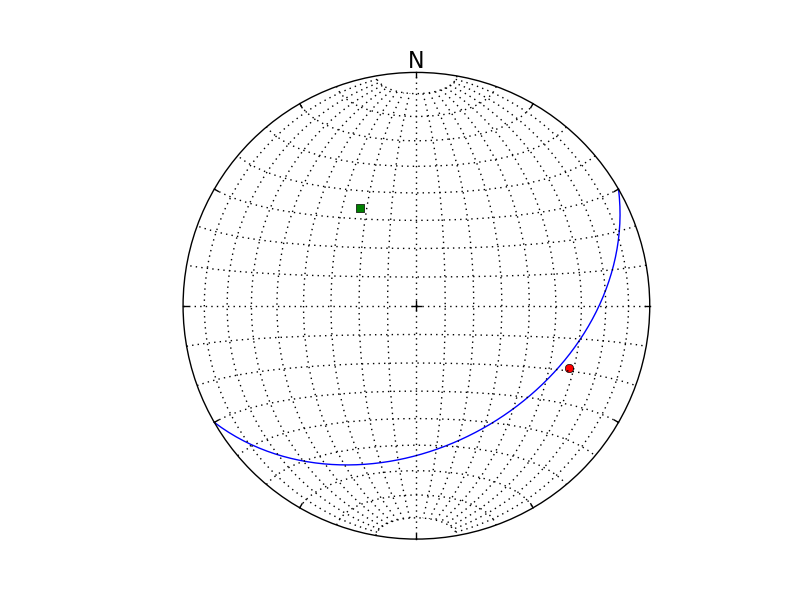
A cones (or small circles) could be plotted as well:
>>> s = StereoNet() >>> g = Group.randn_lin(mean=Lin(40, 15)) >>> s.line(g, 'k.') >>> s.cone(g.R, g.fisher_stats['a95'], 'r') # confidence cone on resultant >>> s.cone(g.R, g.fisher_stats['csd'], 'g') # confidence cone on 63% of data >>> s.show()
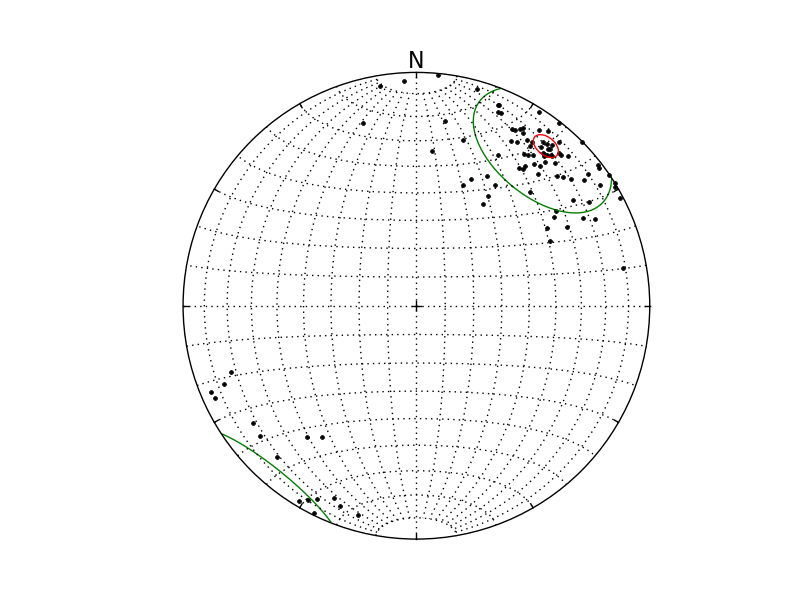
To make density contours plots, a contour and contourf methods are available:
>>> s = StereoNet() >>> g = Group.randn_lin(mean=Lin(40, 20)) >>> s.contourf(g, 8, legend=True) >>> s.contour(g, 8, colors='k') >>> s.line(g, 'wo') >>> s.show()
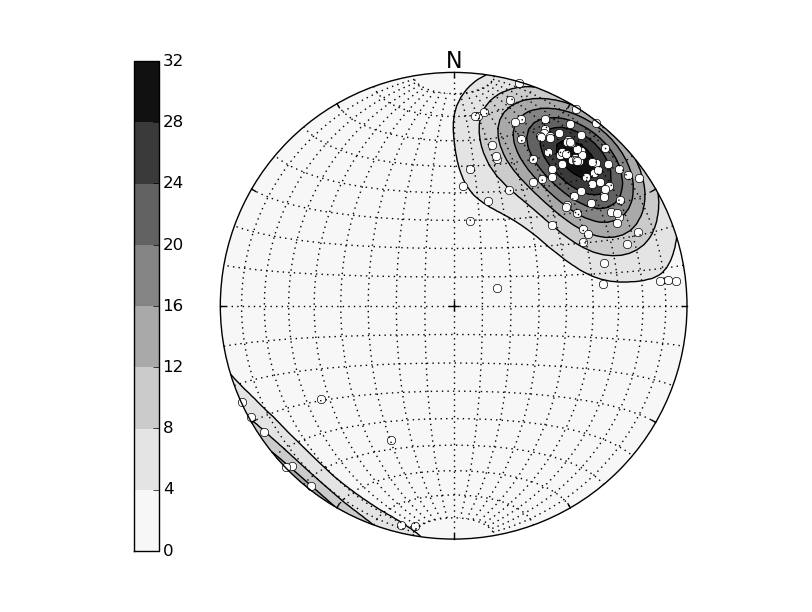
Some tricks
Double cross product is allowed (note quick plot feature):
>>> p = Fol(250,40) >>> l = Lin(160,25) >>> StereoNet(p, l, l**p, p**l, l**p**l, p**l**p)
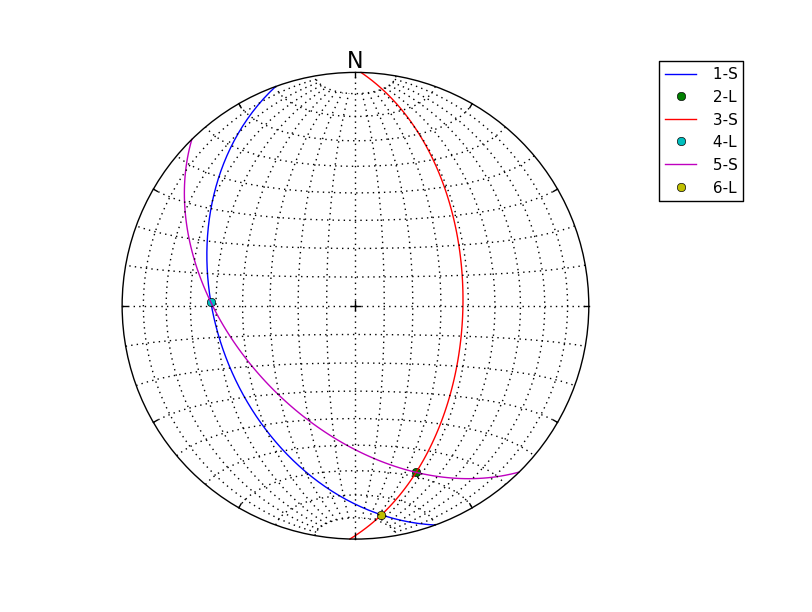
Correct measurements of planar linear pairs by instantiation of Pair class:
>>> pl = Pair(250, 40, 160, 25) >>> pl.misfit 18.889520432245405 >>> s = StereoNet() >>> s.plane(Fol(250, 40), 'b') >>> s.line(Lin(160, 25), 'bo') >>> s.plane(pl.fol, 'g') >>> s.line(pl.lin, 'go') >>> s.show()
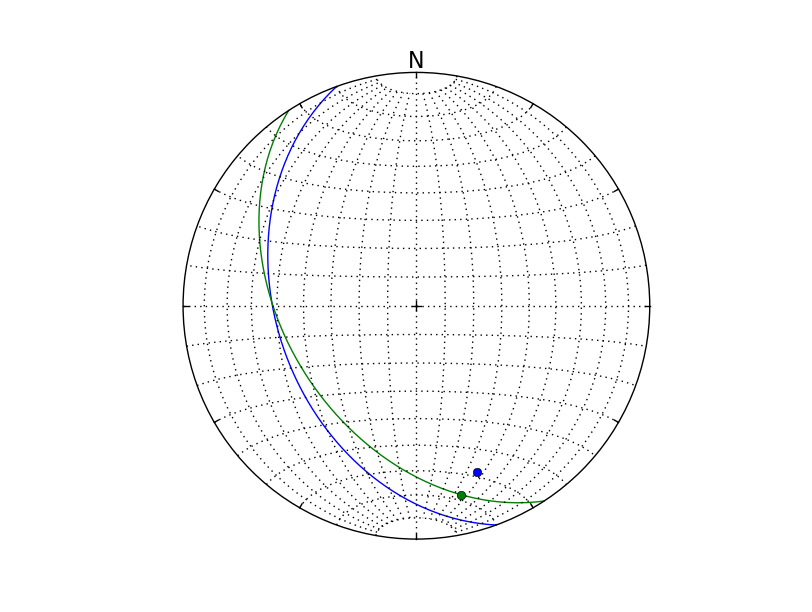
History
0.1.0 (01 Nov 2014)
First release of APSG
0.2.0 (09 Dec 2014)
new StereoNet class for Schmidt projection
Quick plot when data are passed to StereoNet class instantiation
mplstereonet dependency depreceated
new Pair and Fault classes to manipulate paired data (full support in future)
new uniform_lin and uniform_fol Group methods
abs for Group implemented to calculate euclidean norms
new Group method normalized
new Group properties and methods to calculate spherical statistics
Project details
Release history Release notifications | RSS feed
Download files
Download the file for your platform. If you're not sure which to choose, learn more about installing packages.











